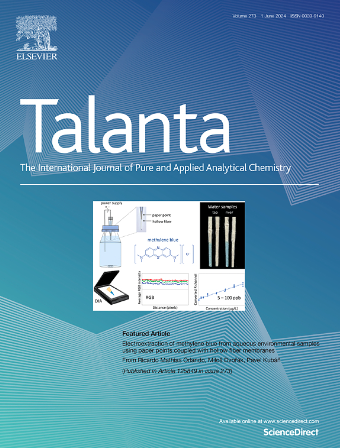A disposable and ready-to-use liquid-filled stick microextraction method for the efficient extraction and determination of triazole fungicide residues in tea beverages and herbal extracts
IF 5.6
1区 化学
Q1 CHEMISTRY, ANALYTICAL
引用次数: 0
Abstract
This study presents a novel liquid-filled stick microextraction (LFSME) method for the efficient extraction of hydrophobic compounds from aqueous samples. The LFSME device, inspired by a single-use swab, consists of a hollow plastic stick pre-filled with a hydrophobic deep eutectic solvent (DES) and wrapped with polypropylene fabric at the end. Upon activation, the DES is released and absorbed by the polypropylene fabric, enabling direct immersion into the sample solution for efficient extraction. The extracted analytes are subsequently desorbed with acetonitrile and analyzed by liquid chromatography with ultraviolet detection. The method demonstrated excellent analytical performance, including high enrichment factors (34–90), good linearity (R2 > 0.99), and low limits of detection (LODs: 0.99–2.61 ng/mL) for the five target triazole pesticides. The disposable and portable nature of the LFSME device eliminates the need for complex sample handling, providing a cost-effective and user-friendly solution for routine monitoring of pesticide residues and other contaminants in complex matrices.

一种一次性即用充液棒微萃取方法,用于茶饮料和草药提取物中三唑类杀菌剂残留的高效提取和测定
本研究提出了一种新型充液棒微萃取(LFSME)方法,用于从含水样品中高效提取疏水化合物。LFSME装置的灵感来自于一次性棉签,它由一个中空的塑料棒组成,预先填充了疏水的深共晶溶剂(DES),并在末端包裹着聚丙烯织物。激活后,DES被释放并被聚丙烯织物吸收,可以直接浸入样品溶液中进行高效提取。提取的分析物随后用乙腈解吸,用紫外检测液相色谱分析。该方法具有较高的富集系数(34 ~ 90)、良好的线性关系(R2 >;低检出限(lod: 0.99 ~ 2.61 ng/mL)。LFSME设备的一次性和便携性消除了复杂样品处理的需要,为复杂基质中农药残留和其他污染物的常规监测提供了经济高效且用户友好的解决方案。
本文章由计算机程序翻译,如有差异,请以英文原文为准。
求助全文
约1分钟内获得全文
求助全文
来源期刊

Talanta
化学-分析化学
CiteScore
12.30
自引率
4.90%
发文量
861
审稿时长
29 days
期刊介绍:
Talanta provides a forum for the publication of original research papers, short communications, and critical reviews in all branches of pure and applied analytical chemistry. Papers are evaluated based on established guidelines, including the fundamental nature of the study, scientific novelty, substantial improvement or advantage over existing technology or methods, and demonstrated analytical applicability. Original research papers on fundamental studies, and on novel sensor and instrumentation developments, are encouraged. Novel or improved applications in areas such as clinical and biological chemistry, environmental analysis, geochemistry, materials science and engineering, and analytical platforms for omics development are welcome.
Analytical performance of methods should be determined, including interference and matrix effects, and methods should be validated by comparison with a standard method, or analysis of a certified reference material. Simple spiking recoveries may not be sufficient. The developed method should especially comprise information on selectivity, sensitivity, detection limits, accuracy, and reliability. However, applying official validation or robustness studies to a routine method or technique does not necessarily constitute novelty. Proper statistical treatment of the data should be provided. Relevant literature should be cited, including related publications by the authors, and authors should discuss how their proposed methodology compares with previously reported methods.
 求助内容:
求助内容: 应助结果提醒方式:
应助结果提醒方式:


